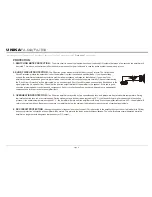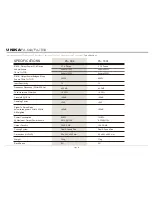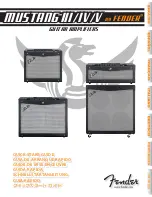
page 7
OPERATING MODES
STEREO OPERATION :
Connect your inputs into channels one and two, also channels three and four of the amplifier. Connect your speakers to the outputs on
the rear of the amplifier. Be sure that your front gain controls are turned down to their lowest level (fully counterclockwise). Turn your amplifier on. Turn your input
source level up. Use your front gain controls to regulate the output volume. Be sure not to raise the volume to the clip level, however an intermittent clip signal is
acceptable.
MONO BRIDGE OPERATION :
Be sure your amplifier and all other audio equipment are powered down. Press the Bridge button. Connect input signals to
channels one and two, or three and four. Connect your speaker across the red output binding post on the rear of your amplifier. Turn your equipment on (your amplifier
should always be the last item you turn on). Apply an input source signal to your amplifier. Use the channel one and three gain controls to regulate your amplifier output.
PARALLEL MONO :
Parallel ties each two channel line inputs together, channels one and two, two and three or three and four, that they will be driven by the same
signal, without the need for external jumpers or wiring. Four amplifier channels will operate independently. Though they carry the same signal, their gain controls affect
only their respective channels, and they both must use their respected speaker outputs. Never attempt to parallel the speaker outputs, this may cause serious damage
to your amplifier! To run in parallel mono mode connect your system as you would if you were going to run in stereo mode. Then press the Parallel button. Be sure the
amplifier is off or the power is disconnected before making any changes.
SUBWOOFER MODE :
This mode sends low frequencies to your speakers without the use of an external cross-over. The subwoofer operation can be operated in
mono only. Set the subwoofer mode switch of the channel three to the “ON” position. Use the frequency selector to adjust the subwoofer output frequency from 20Hz to
200Hz. In addition, the channel two and channel three “PARALLEL” switch sets these two channels in parallel mode, therefore when the “Subwoofer” switch is set to
ON, channel two will simultaneously operated as a subwoofer channel same as channel three.
ONE CHANNEL NORMAL / ONE CHANNEL SUBWOOFER (BI-AMP) -
You may also use your amplifier to bi-amp your system. You may use one side of the amplifier
to power a subwoofer and the other side to power a full range speaker. Follow the set-up guides listed above to mix and match your operations.
UNiKA
PA-664/PA-1804
Figure
10
Mono Bridge Mode Connection
MONO SUBWOOFER SPEAKER
SPEAKER IMPEDANCE MINIMUM 8 OHM
Set to Bridge
Negative (-) Lead
Positive (+) Lead
PA-1804 Rear Panel
Set to Bridge
MONO SUBWOOFER SPEAKER
SPEAKER IMPEDANCE MINIMUM 8 OHM
Negative (-) Lead
Positive (+) Lead
CH4 & CH3
CH2 & CH1
CH 4
CH 3
INPUT
PARALLEL
INPUT
PARALLEL
BRIDGE
BRIDGE
CH 1
CH 2
CH-3
_
+
CH-4
_
+
+
+
_
_
BRIDGE
MONO
BRIDGE
MONO
CH-1
_
+
CH-2
_
+
AC IN
BREAKER
RESET
4 CHANNEL INPUT BALANCE
CAUTION
2 OHMS MINIMUM IMPEDANCE PER CHANNEL
4 OHMS MINIMUM IMPEDANCE IN MONO BRIDGE MODE
GROUND
LIFT
200Hz
20Hz
~120VAC 60Hz
1500 WATTS
FREQUENCY
SUB WOOFER
ON / OFF
CH3 & CH2
PARALLEL
CH 4
CH 3
CH 2
CH 1
15
A
M
P
Important Precautions Introduction
Front Panel Rear Panel Set Up
Protection Specifications
Operating Modes






























